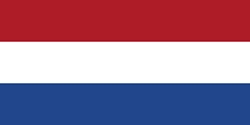
The Netherlands
Number of Soldiers: 3,000
Description
The Dutch notion of security was defensive in nature, and based on the idea of flooding the land by “pressing one button” in order to open the floodgates. Before the war, the Dutch also set up a defense disposition that comprised 3 lines, from the border with Germany inward, 2 of them along each side of the River Meuse. These were supported by a watercourse, which was supposed to be the last line of defense. The reliance on the flooding concept was similar to the French reliance on the Maginot Line and caused complacency in the Dutch Military and Government that did not take into account swift operations, such as the use of airborne and parachuted Forces and of rapid armored columns who performed in blitz wars (“Blitzkrieg”). To that one must add the pacifistic atmosphere prevailing in the Country at the time, which contributed in no small measure to the Army’s incompetence – the shortage of modern combat means, the lack of operational experience, and more.
On the eve of the German invasion of the Netherlands, the Dutch Army numbered approximately 400,000 persons and comprised 4 Corps, each one of them including 2 Divisions. Also included in the Army were another 4 independent Regiments and several smaller Units. This significant Force did not possess even one Tank. The “Armored” Force-Array consisted of only 26 Armored Cars and the Artillery Force consisted of about 650 obsolete Cannons.
The Dutch Fleet was small and comprised 5 Cruisers, 8 Destroyers, 24 Submarines, various Auxiliary Vessels and about 50 obsolete Airplanes. Most of it was allocated for the defense of the East Indies (Indonesia), which were then a Dutch Colony. Very few Vessels were found in the Netherlands itself at the time of the German Invasion, and of those, the sole Destroyer was sunk from the air, and the sole Cruiser and some other Vessels managed to escape to Britain and join the Royal Navy. Most of the Vessels present in the East Indies were sunk by the Japanese, in attacks from the air and in the Naval Battles in the Java Sea and the Sunda Strait.
The Air-Force was small too and on the eve of the German Invasion comprised merely 175 Airplanes, of which only about 130 were operational and around half of those were modern Aircraft.
On the first day of the Offensive the Air-Force lost about 60 planes, and few were left after the surrender.
All these Forces were no match against the German Forces, who invaded the Netherlands on the night of 9-10 May 1940. Five days later, on 14 May, the Dutch Army surrendered to the crushing power of the German Army.
The Dutch Army’s casualties in these Battles amounted to 2,100 dead and about 2,700 wounded.
Queen Wilhelmina and the Dutch Government fled to Britain and established there a Government-in-Exile. The Germans quickly formed their own Rule in the Netherlands that operated parallel to a Dutch Authority.
Dutch Pilots who had fled to Britain joined the Royal Air-Force, and, as mentioned, so did the Vessels that reached this Country.
The Ground Force raised a Regiment that was given the name of “Princess Irene Brigade”. This Brigade fought in Normandy and later in northwest Europe. (See also in the “Partisans” section.)